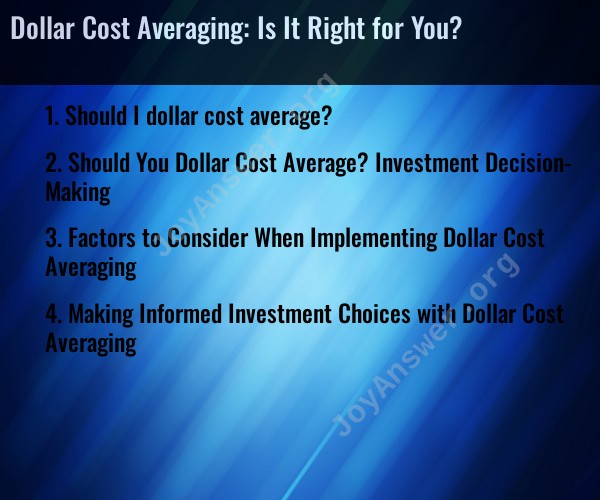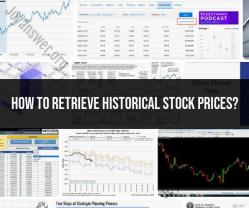Should I dollar cost average?
Dollar cost averaging (DCA) is an investment strategy that involves investing a fixed amount of money at regular intervals, regardless of the price of the investment. This approach is designed to reduce the impact of market volatility and allows you to buy more shares when prices are low and fewer shares when prices are high. Whether you should employ dollar cost averaging depends on your individual financial goals, risk tolerance, and investment strategy. Here are some factors to consider:
When Dollar Cost Averaging May Be Right for You:
Long-Term Investing: Dollar cost averaging is well-suited for long-term investors who are willing to hold their investments for an extended period, typically five years or more. It can help you smooth out the effects of market volatility over time.
Risk Aversion: If you are risk-averse and uncomfortable with the idea of making a lump-sum investment that could be affected by short-term market fluctuations, DCA can help you ease into the market gradually.
Predicting Market Timing Is Difficult: Market timing is challenging, even for experienced investors. DCA eliminates the need to accurately time the market and reduces the risk of making a significant investment just before a market downturn.
Emotional Discipline: DCA can help investors avoid emotional decision-making, such as panic selling during market downturns or making impulsive investment decisions based on short-term market movements.
When Dollar Cost Averaging May Not Be the Best Choice:
Lump-Sum Investing: If you have a large sum of money available for investment and are comfortable with the associated risks, you might consider lump-sum investing. Historically, markets have generally trended upward over the long term, and investing a lump sum can potentially result in higher returns over time.
Short-Term Investment Horizon: DCA is typically better suited for long-term investing. If you have a short-term investment horizon or specific financial goals with a fixed timeline, other investment strategies might be more appropriate.
Market Momentum: In a strongly upward-trending market, dollar cost averaging may result in missed opportunities for higher returns. If you believe the market is in a clear uptrend, you might consider lump-sum investing.
High Transaction Costs: Frequent small investments can lead to higher transaction costs, such as brokerage fees. You should consider these costs when implementing a DCA strategy.
Ultimately, the decision to use dollar cost averaging or another investment approach depends on your financial situation, goals, and risk tolerance. You might also consider a hybrid approach, combining lump-sum investments with periodic contributions, to balance your risk exposure and take advantage of market opportunities.
Before making any investment decisions, it's advisable to consult with a financial advisor or investment professional who can help you develop a strategy tailored to your specific needs and circumstances.
Should You Dollar Cost Average? Investment Decision-Making
Dollar-cost averaging (DCA) is an investment strategy in which an investor invests a fixed amount of money at regular intervals, regardless of the price of the investment. This can be a good way to reduce the impact of volatility on the overall cost of your investments. However, it is important to consider your individual investment goals and risk tolerance when deciding whether or not to use dollar-cost averaging.
Factors to Consider When Implementing Dollar Cost Averaging
Here are some factors to consider when deciding whether or not to use dollar-cost averaging:
- Your investment goals: What are you hoping to achieve with your investments? If you are saving for a long-term goal, such as retirement, then dollar-cost averaging may be a good strategy for you. This is because it can help you to buy more shares when the market is down and fewer shares when the market is up.
- Your risk tolerance: How much risk are you comfortable with? If you are risk-averse, then dollar-cost averaging may be a good strategy for you. This is because it can help you to reduce the overall volatility of your portfolio.
- Your time horizon: When do you need to access your money? If you need to access your money in the short term, then dollar-cost averaging may not be the best strategy for you. This is because the market can be volatile in the short term, and you could lose money on your investments.
Making Informed Investment Choices with Dollar Cost Averaging
If you decide that dollar-cost averaging is the right strategy for you, there are a few things you can do to make sure that you are using it effectively.
- Invest regularly: It is important to invest regularly in order to benefit from dollar-cost averaging. This means investing the same amount of money at the same intervals, regardless of the market conditions.
- Choose the right investments: When choosing investments for your dollar-cost averaging strategy, it is important to consider your individual investment goals and risk tolerance. You should also choose investments that have historically been volatile.
- Rebalance your portfolio regularly: It is important to rebalance your portfolio regularly to ensure that your asset allocation remains aligned with your investment goals and risk tolerance.
By following these tips, you can use dollar-cost averaging to make informed investment choices and reduce the overall volatility of your portfolio.
Please note that this is just a general overview of dollar-cost averaging. It is important to speak with a financial advisor to develop an investment strategy that is right for you.












